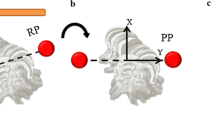Abstract
Idiopathic scoliosis involves complex spinal intrinsic deformations such as the wedging of vertebral bodies (VB) and intervertebral disks (ID), and it is obvious that the clinical evaluation obtained by the spinal projections on the two-dimensional (2D) radiographic planes do not give a full and accurate interpretation of scoliotic deformities. This paper presents a method that allows reconstruction in 3D of the vertebral body endplates and measurement of the 3D wedging angles. This approach was also used to verify whether 2D radiographic measurements could lead to a biased evaluation of scoliotic spine wedging. The 3D reconstruction of VB contours was done using calibrated biplanar X-rays and an iterative projection computer procedure that fits 3D oriented ellipses of adequate diameters onto the 3D endplate contours. “3D wedging angles” of the VB and ID (representing the maximum angle between adjacent vertebrae) as well as their angular locations with respect to the vertebral frontal planes were computed by finding the positions of the shortest and longest distances between consecutive endplates along their contour. This method was extensively validated using several approaches: (1) by comparing the 3D reconstructed endplates of a cadaveric functional unit (T8-T9) with precise 3D measurements obtained using a coordinate measuring machine for 11 different combinations of vertebral angular positions; (2) by a sensitivity study on 400 different vertebral segments mathematically generated, with errors randomly introduced on the digitized points (standard deviations of 0.5, 1, 2, and 3 mm); (3) by comparing the clinical wedging measurements (on postero-anterior and lateral radiographs) at the thoracic apical level of 34 scoliotic patients (15° < Cobb < 45°) to the computed values. Mean errors for the 11 vertebral positions were 0.5 ± 0.4 mm for VB thickness, less than 2.2° for endplate orientation, and about 11° (3 mm) for the location of the maximum 3D wedging angle along the endplate contour. The errors below 2 mm (introduced on the digitized points) slightly affected the 3D wedging angle (< 2°) and its location (< 4°) for the ID. As for the clinical evaluation, average angular errors were less than 0.4° in the radiographic frontal and lateral planes. The mean 3D wedged angles were about 4.9°± 1.9° for the VB and 6.0°± 1.7° for the ID. Linear relations were found between the 2D and the 3D angles, but the 3D angles were located on diagonal planes statistically different than the radiographic ones (between 100° and 221°). There was no statistical relation between the 2D radiographic angles and the locations of the 3D intervertebral wedging angles. These results clearly indicate that VB and ID endplates are wedged in 3D, and that measurements on plain radiographs allow incomplete evaluation of spinal wedging. Clinicians should be aware of these limitations while using wedging measurements from plain radiographs for diagnosis and/or research on scoliotic deformities.
Similar content being viewed by others
Author information
Authors and Affiliations
Additional information
Received: 4 January 1997 Revised: 26 July 1997 Accepted: 1 August 1997
Rights and permissions
About this article
Cite this article
Aubin, CE., Dansereau, J., Petit, Y. et al. Three-dimensional measurement of wedged scoliotic vertebrae and intervertebral disks. E Spine J 7, 59–65 (1998). https://doi.org/10.1007/s005860050029
Issue Date:
DOI: https://doi.org/10.1007/s005860050029




